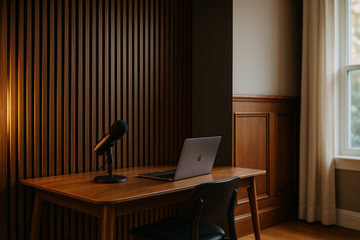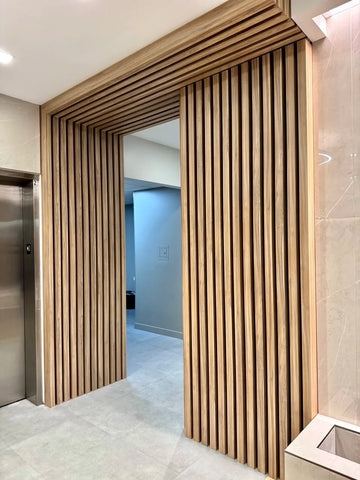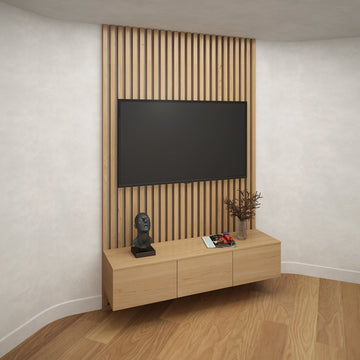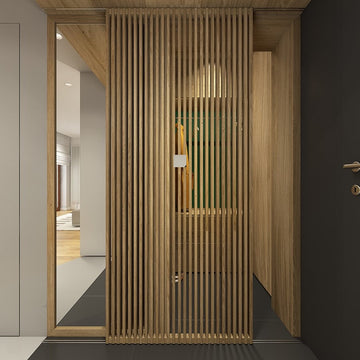Walk into any bright LA apartment or glass-happy office and clap once. If you hear that hard “tick” bounce back at you, your room is working against you. Concrete floors, tall plaster walls, wide windows, open plans — Los Angeles architecture is gorgeous, but it’s not shy about reflections. That’s why so many Zoom rooms sound like tiled bathrooms and why editing voice recordings at home can feel like mopping the ocean.
This is where wood slat panels earn their keep. They don’t just look refined; built the right way, they change what you hear. Below is a practical, field-tested guide from our install team at Element Decor — what slats are made of, how they affect NRC and RT60, where to put them for a home office or project studio, and how to get camera-ready design without turning your space into a muffled music booth.
Why Rooms Echo: The Short Version You’ll Actually Use
Most rooms struggle with three basic behaviors:
-
Reflection — sound hits a hard surface and bounces back. Glass, painted drywall, concrete, stone.
-
Absorption — sound sinks into soft or porous material and loses energy. Felt, mineral wool, fabric.
-
Diffusion — sound is scattered in many directions, breaking up harsh reflections. Grooves, flutes, irregular geometry.
A good-sounding room is a blend. Too reflective and voices smear; too absorptive and the room feels dead. Wood slat panels are a rare two-for-one: the felt backing + air gap absorb energy, while the slats themselves scatter what’s left so you don’t get that flat “thud” of over-treated foam.
Two terms matter:
-
NRC (Noise Reduction Coefficient) — a single number from 0 to 1. Higher = more absorption across mid/high frequencies.
-
RT60 (reverberation time) — how long sound takes to decay by 60 dB. For home offices and small studios, you’ll usually want 0.3–0.5 s. If you hear your voice hang in the air, your RT60 is too long.
LA homes and offices tend to push RT60 up: glass sliders, smooth stucco, open kitchens, minimal rugs. Slats with acoustic backing push it down without killing the vibe.
What Makes a Slat Panel “Acoustic”
Not every slatted wall is acoustically effective. Here’s what actually moves the needle:
-
Layered assembly
-
Face: walnut, oak, or ash veneer on MDF/plywood (stable), or solid wood for special briefs.
-
Backer: acoustic felt — think dense, fibrous material that turns sound energy into heat.
-
Air gap: space between the backer and the wall, often created by furring strips. Even 10–25 mm helps; more depth extends absorption lower.
-
Mounting: adhesive + screws or cleat systems; edge trims for clean terminations.
-
Spacing and depth
-
Typical spacing between slats: 12–25 mm. Narrower spacing = more surface area and smoother diffusion.
-
Slat depth plus the air gap determines how much of the voice range you can tame.
-
NRC in the real world
-
With felt and a modest gap, slat assemblies land in the NRC ~0.45–0.85 neighborhood depending on details. Numbers vary, but the subjective effect is clear: less echo, cleaner speech.
We’re not asking you to carry a decibel meter. We’re saying: you’ll hear it.
Materials & Finishes: Not Just About Looks
At Element Decor, we build for performance and design. Here’s how materials influence both:
-
Core & veneer: We default to MDF or plywood cores for stability; they keep lines straight through LA’s humidity swings. Veneers in walnut, oak, ash take natural oil or matte polyurethane beautifully.
-
Solid wood: Unbeatable presence for certain projects; heavier and pricier, with more movement.
-
Felt/backer: Density matters. Thicker, denser felt or mineral-wool backers return better NRC, especially paired with an air gap. Fire-rated options exist for commercial interiors.
-
Finish: Low-VOC finishes keep home offices and studios healthy. We test under your actual lighting so tones don’t surprise you.
Placement That Actually Works (Home Office & Studio)
Treating the right area beats treating everything.
1) The wall behind you (as the camera sees it)
When you speak to a mic or laptop, your voice travels forward, hits the wall behind your camera, and bounces straight back into the mic with a small delay. That’s the echo you hear on Zoom. A slatted feature wall behind the camera — i.e., behind you — often yields the biggest improvement for calls.
2) Side reflections
If your desk sits centered between two walls, sound ricochets left–right–left. Panels on the first reflection points (roughly where a mirror would show your face from the listening position) help speech intelligibility.
3) The back wall (behind the speakers/monitors)
For edit suites or music corners, the back wall often generates flutter echo. Slats here smooth the field without killing life in the room.
4) The ceiling
Hard ceilings are sneaky. In open plans with tall volumes, a slatted ceiling or acoustic baffles cut reverb more effectively than treating a single wall. Bonus: gorgeous light when you graze slats with a linear LED.
5) Corners & bass
Slats are great for mids and highs. If bass build-up is the villain (small rooms, powerful speakers), add corner traps or build depth into a slatted wall with porous fill to extend absorption lower.
Acoustic Ceiling Baffles vs. Slatted Ceilings
We install both across LA. Choose by use case:
-
Baffles (individual blades)
-
Efficient for large, echoey rooms (coworking, kitchens that double as offices).
-
Easy integration of sprinklers, HVAC, track lighting.
-
A strong architectural gesture that leaves the ceiling “porous.”
-
Continuous slatted ceiling
-
Seamless look; lines draw you through the space.
-
Excellent for grazing light — that soft glow that makes wood read like sculpture.
-
Slightly more planning for access panels; the result feels custom.
Either approach moves RT60 the right way and looks far more elevated than foam tiles.
How We Measure “Better” Without Lab Gear
We love hard data, but you don’t need a suitcase of microphones.
-
Clap/whisper test — Before installation, clap and record on your phone; repeat after. Same spot, same gain. The difference will be obvious.
-
Simple apps — Several free tools estimate RT60 and visualize frequency response from a phone mic. Not lab-grade, but enough to confirm progress.
-
What to expect — In a lively home office, a treated wall + modest ceiling work can shave ~0.2–0.5 s off RT60 and make speech crisp at normal volume. Music and podcasts feel closer and less “roomy.”
For a tighter A/B, keep variables constant: record at the same time of day (HVAC/windows closed), put your phone or mic at ear height about 1 m from the treated wall, and read the same 10-second script at the same distance/volume. If you have a small speaker, play pink noise at a fixed level and measure again to see decay more clearly. Turn off any auto-gain on the recording app if possible, then export both takes and compare in a free analyzer (waveform/ spectrogram) or simply do a blind listen with headphones. As a final check, join a Zoom/Meet test call and record locally — the fewer early reflections you
Installation Workflow (What Our Crew Actually Does)
We aim for beautiful sound and cleaner lines than your camera can fully capture.
-
Site check & layout — laser, stud finder, tapping for hollows. We plan cable routes, TV mounts, and LED placement before any panel goes up.
-
Substrate prep — if the wall’s wavy, furring strips shim everything flat. Slats amplify unevenness, so prep matters.
-
Mounting — panelized sections on cleats; adhesive + screws locked into studs. Edge trims for windows, door casings, and inside corners.
-
Power & LEDs — we rough in power and control, then tuck drivers in accessible places. Grazing light brings slats to life and emphasizes rhythm.
-
Safety & code — Class A/B finishes for commercial spaces when needed; low-VOC systems for home offices and studios.
A typical feature wall is 1–2 days. Slatted ceiling: usually 1–3 days depending on penetrations and lighting.
Design That Works on Camera
You’re not just designing a room — you’re designing a frame that millions of pixels will stare at during meetings.
-
Direction matters:
-
Vertical slats silently raise the ceiling; great behind a desk.
-
Horizontal slats widen narrow rooms; use intentionally for podcast backdrops.
-
Avoid moiré: Medium slat spacing (14–20 mm) typically plays nicer with sensors than ultra-fine textures.
-
Finish & light: Matte or open-pore finishes reduce glare. A warm, dimmable grazer softens features and reads premium on camera.
LA-Specific Considerations (Sun, Salt, and Schedule)
-
Sunlight: Afternoon sun in Santa Monica or DTLA can be aggressive. We spec UV-resistant finishes or propose sheer shading if one wall bakes daily.
-
Air & moisture: Coastal air vs. valley dryness — the reason we love stable cores and equilibrated wood.
-
Scheduling: For offices, we install evenings or weekends to keep teams focused. For residences, we mask like we’re painting a classic car.
Budget & Value: What Drives Price — and ROI
You won’t find fake one-size-fits-all numbers here. Instead, here’s what affects cost and perceived value:
-
Species/finish — walnut typically prices above oak; oil vs. matte poly; brass/black inlays add time and skill.
-
Area & access — tall ceilings, stair walls, built-ins to work around, windows that need clean terminations.
-
Performance layer — felt density, air gap depth, and whether we integrate additional porous fill.
-
Lighting — linear LED, drivers, dimming, smart control.
-
Ceiling vs wall — overhead work takes longer; results can be transformative in open plans.
Where ROI is highest: camera-facing home offices, podcast corners, media walls, and small studios where clarity is king. Clients often tell us they stopped wearing headsets and lowered their speaking volume. That’s real value, all day.
Three LA Case Snapshots
1) Pasadena home office
A glassy addition turned into a Zoom echo chamber. We installed walnut slats on the wall behind the desk with 12 mm felt and a 20 mm air gap, plus a short slatted cloud over the desk for first reflections. Before/after voice memos sounded like two different rooms. The client’s review line: “I stopped apologizing for my audio.”
2) DTLA one-room studio
Open concrete, metal ductwork, great vibe, terrible reverb. We ran oak acoustic baffles across the ceiling with integrated linear light, then a horizontal slat feature on the back wall to break up flutter. RT60 dropped into the mid-0.4s; they can track voiceovers without a blanket fort.
3) Santa Monica apartment nook
No room for rugs or heavy curtains, but a north wall for recording. A narrow slatted panel field with denser felt, plus simple drapery on the opposite window. Small move, big change — podcasts now sound intimate instead of echo-chambered.
Practical Tips You Can Use Today
-
Treat what the mic “sees.” Start with the wall behind the camera and the ceiling above your desk.
-
Add depth if you can. Even a 15–25 mm air gap behind felt helps — don’t glue slats flat to bare concrete if you can avoid it.
-
Mind cable paths. Slatted fields are perfect for hiding power strips, HDMI, and Ethernet. We plan access points so maintenance stays easy.
-
Think in pairs. A treated wall + a modest ceiling element feel more natural than over-soaking one surface.
-
Measure casually. Do a phone recording before and after. You’ll hear the delta — even your clients will.
One more thing: light the texture on purpose. Slats come alive under grazing light, and that light also helps your mic by reducing slap from the ceiling and the wall in front of you. If you can, add a dimmable linear LED or track aimed across the slats (not straight at them), keep finishes matte or open-pore to avoid harsh glare, and set color temperature around 2700–3500K for natural skin tones on camera. It’s a tiny upgrade that makes both your sound and your picture feel instantly “studio.”
Frequently Asked Questions
Do slat walls really absorb sound, or do they just look nice?
They do both. The felt/backer + air gap absorb; the slats scatter (diffuse). Together they improve NRC and speech intelligibility without turning the room dull.
What NRC should I aim for in a home office?
There’s no magic number, but if your room is glassy, combinations that net NRC ~0.6–0.8 on treated areas usually bring RT60 into a comfortable 0.3–0.5 s range.
Will slats fix bass problems?
Not directly. Slats excel in mids/highs. For bass, add corner traps or design deeper assemblies with porous fill. We’ll advise after a quick room read.
Can slats go on ceilings?
All the time. Ceilings often win bigger gains than a single wall, especially in open plans. Baffles are great for services (sprinklers/HVAC), continuous slats for seamless design.
How hard are they to clean?
Grooves collect a little dust. A vacuum brush and microfiber keep them fresh. Matte finishes hide fingerprints better than gloss.
Is veneer worse than solid wood?
Not for acoustics. Veneer on a stable core stays straighter across seasons, looks beautiful, and keeps costs sensible. We use solid wood when a project calls for it — handrails, edges, or that one-of-a-kind piece.
What about fire and indoor air?
We can spec Class A/B systems for commercial work and low-VOC finishes for wellness-minded homes and studios.
How We Work at Element Decor (LA)
-
Show us your space. A phone photo with rough dimensions beats a thousand emails.
-
We visualize. In 2–5 business days, we return a 3D visualization that shows slat spacing, veneer tone, lighting, and budget.
-
We sample. Walnut vs. oak, felt color, finish sheen — decide with real pieces under your actual lighting.
-
We fabricate & install. Clean edges, straight lines, no chaos. Evenings/weekends for offices, dust control for homes.
-
We’re local. Need to extend the wall later or add a slatted ceiling? We’re a quick call away.
If your LA home office or studio is hard, echoey, and camera-facing, wood slat panels are a smart, beautiful fix. They lower reverb, clarify speech, and elevate the room’s design in a way soft panels rarely can. Add a slatted ceiling or a few acoustic baffles, and you’ll hear the space exhale.
Ready to hear it for yourself? Upload your drawing or a quick sketch, and we’ll return a 3D visualization in 2–5 days with finish options, a clean plan, and a clear price. Prefer tactile first? Order a sample kit — walnut, oak, felt colors, and a couple of spacing profiles. We’ll help you dial in a room that looks like Los Angeles and sounds like you.




